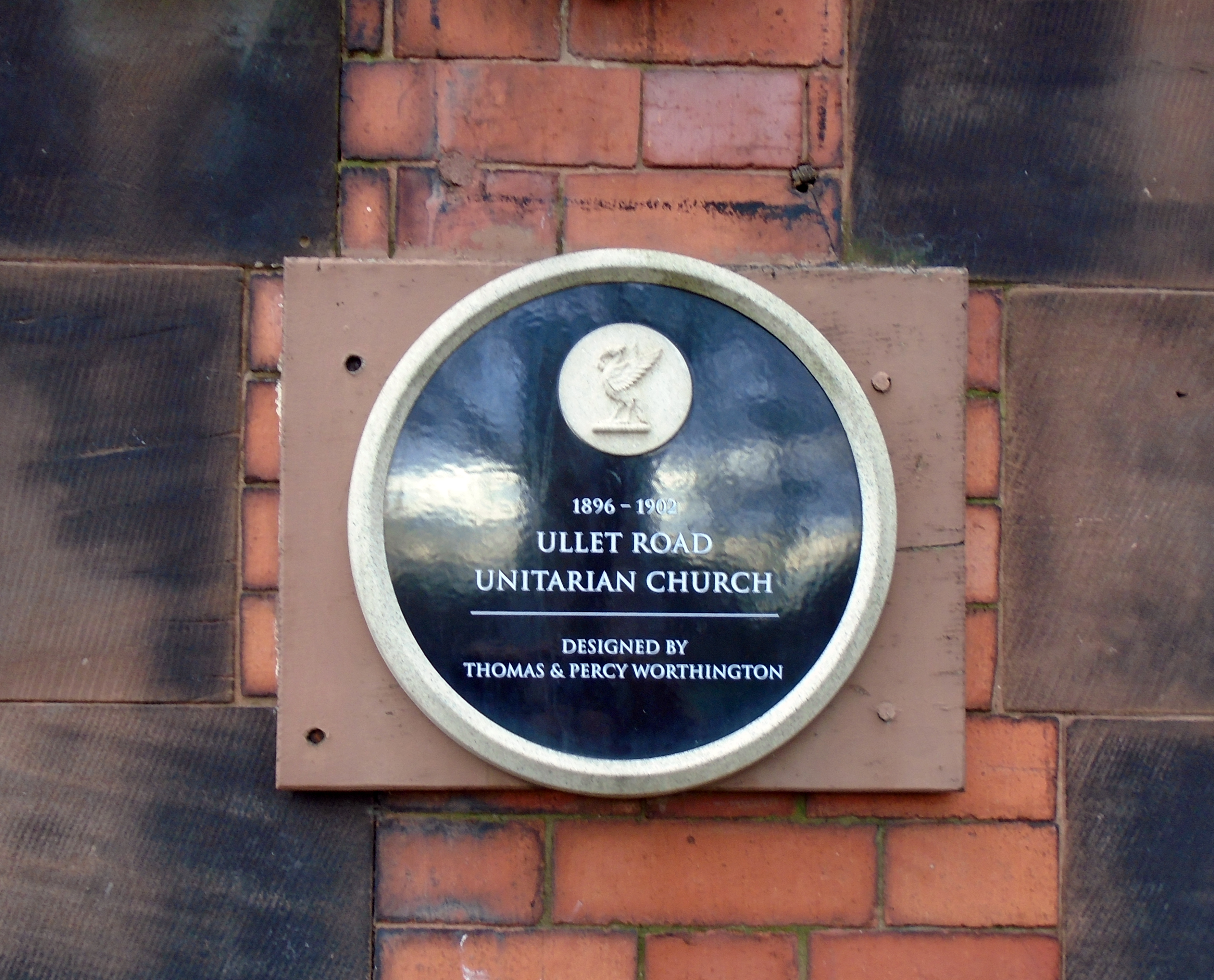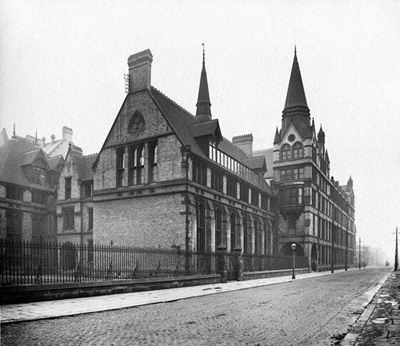|
Percy Worthington
Sir Percy Scott Worthington (31 January 1864 – 15 July 1939) was an English architect. He was born in Crumpsall, Manchester, the eldest son of the architect Thomas Worthington. He was educated at Clifton College, Bristol, and Corpus Christi College, Oxford, where he graduated in 1887, and he qualified as an architect in 1890. He subsequently worked as assistant to John Macvicar Anderson in London, attending the Royal Academy Schools and University College London, before returning to his father's office where he was made a partner in 1891. He continued the business after his father's death along with his much younger brother Hubert Worthington, who became a partner in 1913. Percy's son Thomas Scott Worthington later joined the partnership. In his early years he was interested in the Arts and Crafts movement and this was reflected in the Unitarian Chapel, Liverpool, which he designed with his father. From 1904 he became more involved in the revival of classicism. He was awarded ... [...More Info...] [...Related Items...] OR: [Wikipedia] [Google] [Baidu] |
Crumpsall
Crumpsall is an outer suburb and electoral ward of Manchester, England, north of Manchester city centre, bordered by Cheetham Hill, Blackley, Harpurhey, Broughton, and Prestwich. The population at the 2011 census was 15,959. Historically part of Lancashire, Crumpsall was a township within the parish of Manchester, Salford Hundred. North Manchester General Hospital is in Crumpsall. History The name Crumpsall derives from old English and means a "crooked piece of land beside a river".Crumpsall: Districts and suburbs of Manchester Retrieved on 08 September 2009 It is first mentioned in 1291. In 1472, Crumpsall was held in socage by James Radcliffe subject to an annual rent of ten |
1939 Deaths
This year also marks the start of the Second World War, the largest and deadliest conflict in human history. Events Below, the events of World War II have the "WWII" prefix. January * January 1 ** Third Reich *** Jews are forbidden to work with Germans. *** The Youth Protection Act was passed on April 30, 1938 and the Working Hours Regulations came into effect. *** The Jews name change decree has gone into effect. ** The rest of the world *** In Spain, it becomes a duty of all young women under 25 to complete compulsory work service for one year. *** First edition of the Vienna New Year's Concert. *** The company of technology and manufacturing scientific instruments Hewlett-Packard, was founded in a garage in Palo Alto, California, by William (Bill) Hewlett and David Packard. This garage is now considered the birthplace of Silicon Valley. *** Sydney, in Australia, records temperature of 45 ˚C, the highest record for the city. *** Philipp Etter took over as Swiss ... [...More Info...] [...Related Items...] OR: [Wikipedia] [Google] [Baidu] |
1864 Births
Events January–March * January 13 – American songwriter Stephen Foster ("Oh! Susanna", "Old Folks at Home") dies aged 37 in New York City, leaving a scrap of paper reading "Dear friends and gentle hearts". His parlor song "Beautiful Dreamer" is published in March. * January 16 – Denmark rejects an Austrian-Prussian ultimatum to repeal the Danish Constitution, which says that Schleswig-Holstein is part of Denmark. * January 21 – New Zealand Wars: The Tauranga campaign begins. * February – John Wisden publishes '' The Cricketer's Almanack for the year 1864'' in England; it will go on to become the major annual cricket reference publication. * February 1 – Danish-Prussian War (Second Schleswig War): 57,000 Austrian and Prussian troops cross the Eider River into Denmark. * February 15 – Heineken brewery founded in Netherlands. * February 17 – American Civil War: The tiny Confederate hand-propelled submarine '' H. ... [...More Info...] [...Related Items...] OR: [Wikipedia] [Google] [Baidu] |
Barrows Green, Near Kendal (2)
Barrow may refer to: Places England * Barrow-in-Furness, Cumbria ** Borough of Barrow-in-Furness, local authority encompassing the wider area ** Barrow and Furness (UK Parliament constituency) * Barrow, Cheshire * Barrow, Gloucestershire * Barrow, Lancashire * Barrow, Rutland * Barrow, Shropshire * Barrow, Somerset * Barrow, Suffolk * Barrow (Lake District), a fell in the county of Cumbria * Barrow upon Humber, Lincolnshire * Barrow upon Soar, Leicestershire * Barrow upon Trent, Derbyshire Ireland * River Barrow, the second-longest river in Ireland * Barrow, a townland in County Kerry, home of Tralee Golf Club United States * Barrow County, Georgia * Barrow, Illinois, an unincorporated community * Utqiaġvik, Alaska (formerly known as Barrow) The Moon * Barrow (crater) People * Barrow (name), a surname, and persons with the name * Barrows (name), a surname, and persons with the name * Musa Barrow, Gambian profession footballer Other uses * Barrow A.F.C., an association f ... [...More Info...] [...Related Items...] OR: [Wikipedia] [Google] [Baidu] |
University Of Manchester Library
The University of Manchester Library is the library system and information service of the University of Manchester. The main library is on the Oxford Road campus of the university, with its entrance on Burlington Street. There are also ten other library sites, eight spread out across the university's campus, plus The John Rylands Library on Deansgate and the Ahmed Iqbal Ullah Race Relations Resource Centre situated inside Manchester Central Library. In 1851 the library of Owens College was established at Cobden House on Quay Street, Manchester. This later became the Manchester University Library (of the Victoria University of Manchester) in 1904. In July 1972 this library merged with the John Rylands Library to become the John Rylands University Library of Manchester (JRULM). On 1 October 2004 the library of the Victoria University of Manchester merged with the Joule Library of UMIST forming the John Rylands University Library (JRUL). The Joule Library was the successor of th ... [...More Info...] [...Related Items...] OR: [Wikipedia] [Google] [Baidu] |
Hulme Hall, Manchester
Hulme Hall is a University of Manchester hall of residence situated at the Victoria Park Campus in Rusholme, Manchester, housing 300 students. It has a range of facilities including the John Hartshorne Centre: a 300 seat lecture theatre with attached seminar rooms; a library; Junior Common Room and study spaces; music room; old dining hall; the Victoria Park bar; and chapel. Local student attractions include the Whitworth Art Gallery and the Curry Mile on Wilmslow Road. The hall is the oldest student accommodation in Manchester, founded in association with Owens College. It was named after the Lancashire lawyer and landowner William Hulme whose Hulme Trust funded the Hall's foundation. It is a Grade II listed building. It should not be confused with the historic Hulme Hall in Hulme, Manchester, on the right bank of the River Irwell, which has been demolished. History The present-day University of Manchester has its roots in Owens College. As the academic profile ... [...More Info...] [...Related Items...] OR: [Wikipedia] [Google] [Baidu] |
Manchester Grammar School
The Manchester Grammar School (MGS) in Manchester, England, is the largest independent school (UK), independent day school for boys in the United Kingdom. Founded in 1515 as a Grammar school#free tuition, free grammar school next to Manchester Cathedral, Manchester Parish Church, it moved in 1931 to its present site at Rusholme. In accordance with its founder's wishes, MGS remains a predominantly academic school and belongs to the Headmasters' and Headmistresses' Conference. In the post-war period, MGS was a direct-grant grammar school. It chose to become an independent school in 1976 after the Labour Party (UK), Labour government abolished the Direct grant grammar school, Direct Grant System. Fees for 2016–2017 were £11,970 per annum. Motto, coat of arms and school badges The school's motto is ''wikt:sapere aude, Sapere Aude'' ("Dare to be Wise"), which was also the motto of the County Borough Council, council of the former County Borough of Oldham (now, with the same coat ... [...More Info...] [...Related Items...] OR: [Wikipedia] [Google] [Baidu] |
Whalley, Lancashire
Whalley is a large village and civil parish in the Ribble Valley on the banks of the River Calder in Lancashire, England. It is overlooked by Whalley Nab, a large wooded hill over the river from the village. The population of the civil parish was 2,645 at the census of 2001, and increased to 3,629 at the census of 2011. The main road through Whalley is King Street, which leads through to Clitheroe Road. Neighbouring Whalley are the small villages of Wiswell, Billington, Barrow, and Read. Close by is Downham village and Pendle Hill which was made famous in William Harrison Ainsworth's book ''The Lancashire Witches''. History Portfield Hillfort also known as Planes Wood Camp, thought to date from late Bronze Age or Iron Age, is located on a slight promontory overlooking the valley of the River Calder southeast of the town. It is one of over 140 Scheduled monuments in Lancashire. Flooding Whalley was severely affected by flooding in December 2015. Hundreds of homes were ... [...More Info...] [...Related Items...] OR: [Wikipedia] [Google] [Baidu] |
Great Warford
Great Warford () is a village and civil parish in the unitary authority of Cheshire East and the ceremonial county of Cheshire, England. A predominantly farming settlement that has existed for about a thousand years, it is now also important for private healthcare and property development. The population today accounts for 1710 inhabitants. There is no real municipal centre in terms of population density and importance; the Warford Park development is home to some 300 people. Its amenities include an on-site health/leisure club, tennis courts, the Warford Park Bowling Club and several acres of gardens, lake, and parkland. Great Warford does not have direct access to national transport networks, lacking both a railway and a bus station. It is, however, in the centre of "The Golden Triangle" subtended by Alderley Edge, Knutsford and Wilmslow. Thus, it is well served by various schools, shops, restaurants, and places of worship and entertainment. The North West's extensive motorw ... [...More Info...] [...Related Items...] OR: [Wikipedia] [Google] [Baidu] |
Peover Superior
Peover Superior is a civil parish in the unitary authority of Cheshire East and the ceremonial county of Cheshire, England. It is described by the Office for National Statistics as a village surrounded by inhabited countryside. The civil parish includes the village of Over Peover and the hamlet of Peover Heath. Peover Superior is named after The Peover Eye river, which forms one of the parish boundaries. There is also a nearby village named Peover Inferior; the two areas are so named due to their standing on the river, with Peover Superior being higher up and Peover Inferior lower down on the river. The village Peover Superior is home to St Lawrence's Church, Over Peover which is a designated National Heritage Grade I listed building. The church was first listed on 5 March 1959. The church was built in three stages which started in 1456 when the South Chapel was built. This was followed by the building of both the North Chapel and the Tower in 1648 and 1741 respectively. The ... [...More Info...] [...Related Items...] OR: [Wikipedia] [Google] [Baidu] |
Radbroke Hall
Radbroke Hall is a white French chateau-style former country house in Peover Superior, Cheshire, England. It takes its name from the Red Brook stream that runs through the grounds. History Radbroke Hall was built between 1914 and 1917 for Manchester businessman Claude Hardy and his wife Olga. The architect was Percy Worthington. Originally from Belfast, Claude Hardy had a successful textile manufacturing business in Manchester. Unfortunately, Claude's death in 1916 left his widow to oversee the completion of the building work alone. The hall is built of Portland stone which was brought by train to a local railway station from Weymouth. Main features of the hall include a white marble staircase, a music room, and an oval dining room. Around the hall were some twenty acres of grounds including attractive rose gardens and areas given over to a large variety of Rhododendrons. The main hall driveway is flanked by large old beech trees. The house and parts of the gardens are recor ... [...More Info...] [...Related Items...] OR: [Wikipedia] [Google] [Baidu] |

_2018.png)
.jpg)




